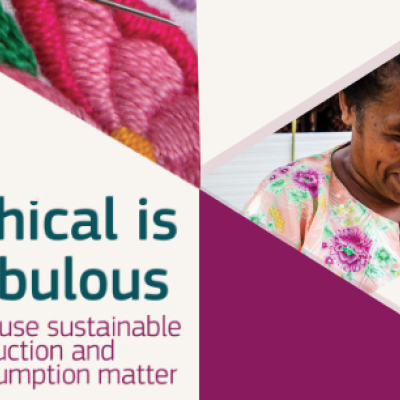At the European Development Days (EDD) 2019, Capacity4dev spoke to representatives from the fashion industry to find out what the next steps are for ethical fashion, and the challenges and opportunities that will come with them.
Representatives from both industrial associations and the private sector explained to us that increasing transparency and traceability will foster sustainable practices in the industry.
Two driving systems
Heinz Zeller, Head of Sustainability and Logistics at Hugo Boss, believes that there will be two main drivers of transparency and traceability in the fashion industry: the loyalty that consumers and stakeholders build through transparency, and the introduction of laws to uphold standards around transparency.
I think that, especially in today’s times, you want to know more about [the] clothes you wear, but you [also] want to know more about the conditions in the factory, so that will completely change the way we can communicate with consumers.
“If you start to be transparent, you create a certain trust, and trust is loyalty,” Zeller said. “I think that, especially in today’s times, you want to know more about [the] clothes you wear, but you [also] want to know more about the conditions in the factory, so that will completely change the way we can communicate with consumers.”
On the other side, he said, “we can impose change through the introduction of laws. I think these will be the two driving systems that push us towards more transparency.”
Zeller also explained why it is crucial to have transparency. To have a positive impact, he said, one has to know where thing have come from – and from whom. “If we don’t have any transparency, how are we going to address sustainability issues,” Zeller asked.
All of Hugo Boss’ direct suppliers are disclosed on the company’s portal, although Zeller pointed out that the problems often lie not within the first tier, but the second, third and even the plantations where cotton is grown.
“We ask our suppliers from whom they are buying cotton, so as to get an understanding and then, of course, steer all our activities towards more sustainable practices with that information,” Zeller added.
Quality control
According to Remo Cali, from the Candiani Denim company, transparency, traceability, sustainability and quality link together in many different ways.
“If we visualise an imaginary pyramid, the top of the pyramid is the transparency, then traceability, sustainability, and the base of the pyramid is quality – not only the mere quality of the product, but also the entire quality of the process: the production, the quality of work conditions and so on,” he said. “From the point of view of the manufacturing processor, the primary focus is on the ingredients, which means the origin.”
Another interviewee, Jo Van Landeghem, from Creamoda, a Belgian fashion house, echoed the need for more transparency and traceability in the fashion industry.
Spearheading a new project called ‘bAwear’, Van Landeghem explained that his goal is to implement sustainable change. “We represent a lot of small and medium enterprises who have been in competition globally with companies that claim a lot, [but] it’s very, very hard to verify those claims,” he said. “Hence, we set up a programme. We are testing out a working method called ‘bAwear’, where we are going to see if we can substantiate all the claims that are being made, whether it’s about the environment or social labour – all those aspects of doing business and explaining why your product is better than another.”
According to Zeller, from Hugo Boss, the next step in increasing transparency could be to set up a platform to jointly store and share information based on the blockchain ecosystem, which is something his company is currently looking into.
Zeller believes that one of the biggest issues in the industry is the difficulty of exchanging information that sometimes needs to be secure and is not always intended for the public.
Cali, from Candiani Denim, supports the idea of collaborating with others in the industry to align and harmonise standards.
It’s crucial to have the same way of evaluating sustainable performances – both social and environmental – so it’s necessary to have the collaboration and support of many organisations for every single aspect of production, in order to find harmonised standards,” he said.
“It’s crucial to have the same way of evaluating sustainable performances – both social and environmental – so it’s necessary to have the collaboration and support of many organisations for every single aspect of production, in order to find harmonised standards,” he said.
As pointed out by Landeghem, another challenge to increasing transparency in the fashion industry is that it is not in all companies’ interest to disclose information. “It will be a challenge for those companies that do not want to be transparent,” he said. “I don’t think there’s room for them anymore – they might need to change to a different sector.”
However, “the good news is that the fashion industry is really changing – they understand that they have to do things differently, and they want to change,” said Jan Merckx, Industry Engagement and Innovation Manager at GS1 Belgium & Luxembourg. “The biggest challenge will be how to achieve this change.”





Log in with your EU Login account to post or comment on the platform.